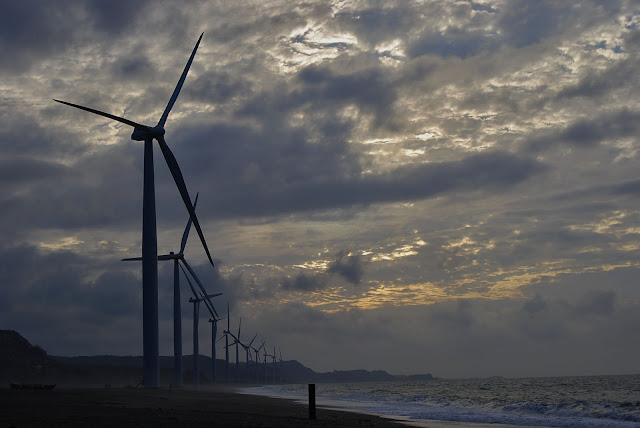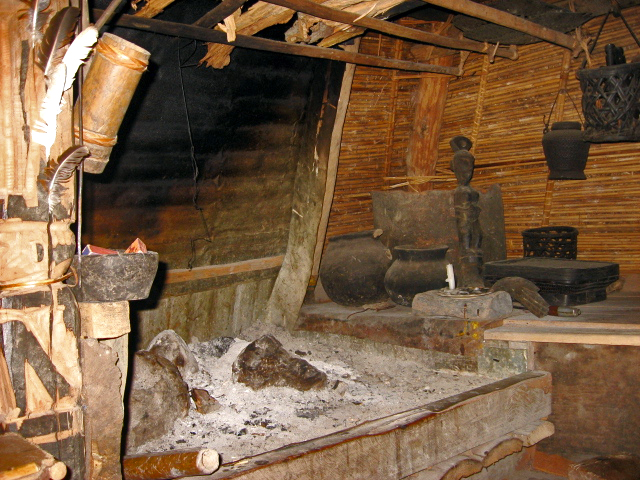 |
| Hmmm empanada and roasted peanuts with lotsa garlic! |
And after several years, I've finally returned to Ilocos and it looks different now. Buildings and commercial establishments are everywhere, some streets are wider and paved and some are narrow due to the volume of trucks, buses, jeepneys and tricycles running in the main streets. I rarely saw "calesas". But there is one thing that still hasn't changed in Batac, it's their flashy orange crispy fried "empanada" in the plaza which always goes with vinegar and garlic that makes everyone crave for it. Those grilled dried squids on sticks displayed on glass shelves, smells a bit fishy but still taste good is a sure winner!
 |
| Yummy! |
So let's continue our journey to the quaint town of Paoay (Pawai), which we all know is very popular for its monumental church. I only see this church in pictures and I was awed while standing right in front of it! The Church of Saint Agustine and its adjoining coral stone bell tower was constructed by the Augustinians in 1694. It is one of the most famous and magnificent building in the region which is listed in the World Heritage Site of UNESCO. The two sides of the facade are extended by curved buttresses giving it a graceful air.
 |
| Grand architecture! |
Its astounding facade displays an immense decor with its massive flying buttresses which gives protection from strong earthquakes. The artistic creation emerges from a beautiful open space, unlike any many other churches located within the urban settings. How do you like that?
Our journey in Paoay wouldn't be complete if we miss the Malacanang of the North and Paoay Lake. We passed by this beautiful two-story vacation house of the former Philippine President Marcos which is now turned to a museum displaying the Marcos memorabilia. It is also a popular venue for wedding receptions and other special events. The museum is open from 9 am until 5 pm with an entrance fee of 20 pesos.
It has a spacious terrace and a beautiful garden at the back with a splendid view of the Paoay Lake. Legend tells that Paoay Lake was once a beautiful dry land. The site of a prosperous barangay called San Juan de Sahagun (Saint John of Sahagun). The materialism of its people has angered God so He sent an earthquake that sank the town. The lake remains to be mystical according to the locals, jewels and gold ornaments on the mouth of fresh caught fish are said to be found by fishermen as proof that the villagers then lived a lavish lifestyle.
I thought I was in Sahara desert when we drove along the wide scope of dry landscape. I walked and ran onto hills of sands and it hurts my feet due to the scorching heat of the sun. The 85 kilometer Paoay sand dunes seemed to be the favorite setting of most Philippine films like "Panday", "Himala" and some other films. What intrigues me most is that how did dunes existed in a tropical country? Could it be under sea water millions of years ago? Or could it be the effect of strong earthquakes which made the ocean move back leaving all these sands? Oh well...what I know is that the place is starting to attract tourists and is now a haven for thrill seekers who would want to try some sand adventures!
 |
| walang himala! |
Heading north again, we passed by an old lighthouse in Burgos, Ilocos Norte. Burgos was named after the martyred priest Jose Burgos who was executed in Manila, it is 50 kilometers north of Laoag. The red brick lighthouse, Cape Bojeador, was constructed in 1892 by the Spaniards. I must admit that I got scared with the ghostly atmosphere as I walked on its creaking wooden aisles along old wooden thick doors, with a height three times as mine. In spite of the ravages and natural elements which damaged it severely, the building still shows the elegance it had during the old days. Today the Burgos Lighthouse still stands on a hill and continue to attract tourists and serves as beacon to all passing vessels along the Philippine sea.
 |
| Creepy. |
Ilocos Norte is really trying to impress me more, I have been to a historical church, a legendary lake, sand dunes, an old lighthouse and this time... windmills? I screamed as the car passed by the main road when I saw the rows of gigantic fans from afar which still looks huge even at a distance! Honestly, the windmills excites me the most as we passed by the coastal town of Bangui. It is odd to see windmills in a small and simple coastal town. The locals must have something to be proud of and I'm telling you it gave me a different feeling as I went nearer and touched its base, see them twirl and makes a loud squeaking sound!
The windmills, officially referred to as the NorthWind Bangui Bay Project, were a project by the NorthWind Development Corporation as a practice renewable energy sources and to help reduce the greenhouse gases that cause global warming. The project is the first “Wind Farm” in the Philippines consisting of wind turbines on-shore facing the South China Sea and considered to be the biggest in Southeast Asia. The project sells electricity to the Ilocos Norte Electric Cooperative (INEC) and provides 40% of the power requirements of Ilocos Norte via Transco Laoag.
How to get here?
From Laoag, take the Laoag-Cagayan route towards Burgos. After reaching Burgos, watch out for the directional marker on the left side of the road that leads to the Bangui Bay. Follow the dirt road leading to the bay. Some wind mills will already be visible from this point then make a right turn to the bay. Travel time from Laoag will approximately be an hour and a half.
"One's destination is never a place, but a new way of seeing things."-Henry Miller
Thank you for reading!
NOTE: Some informations in this blog were taken from the book. "Places With A Heart Philippines".



















































